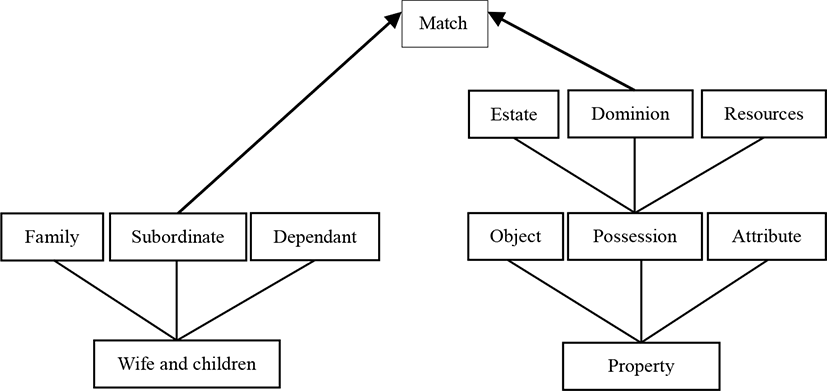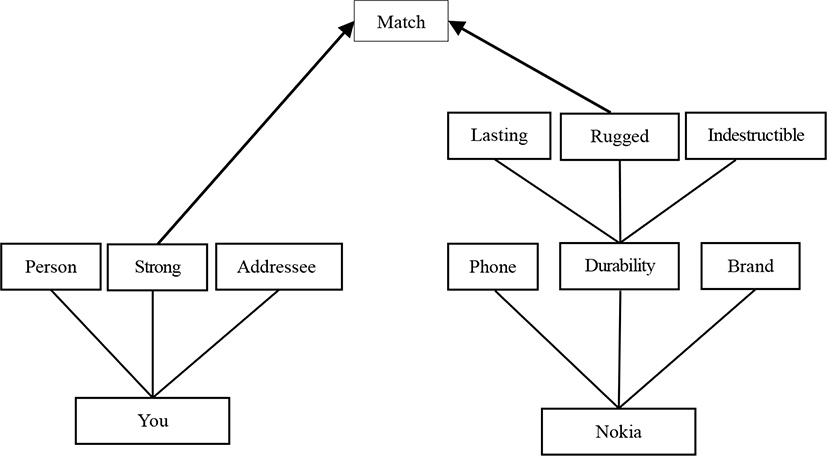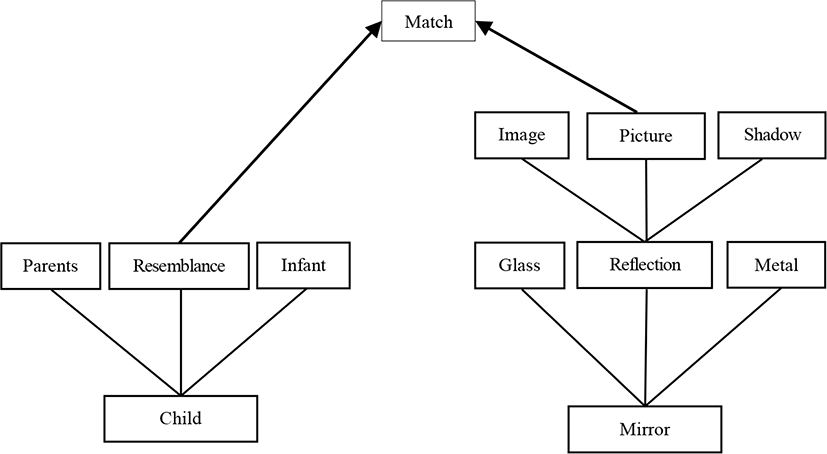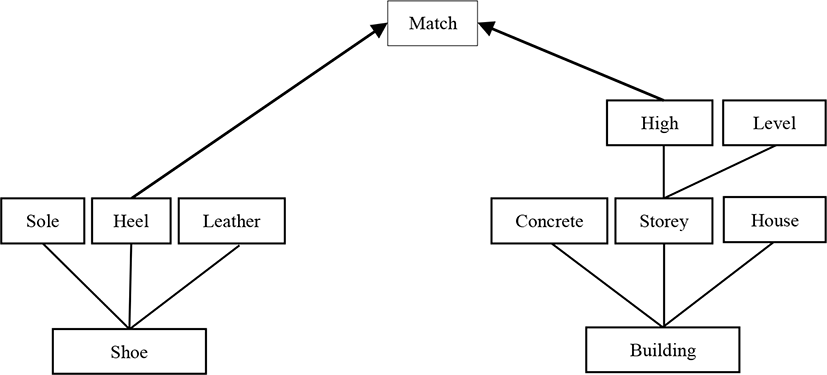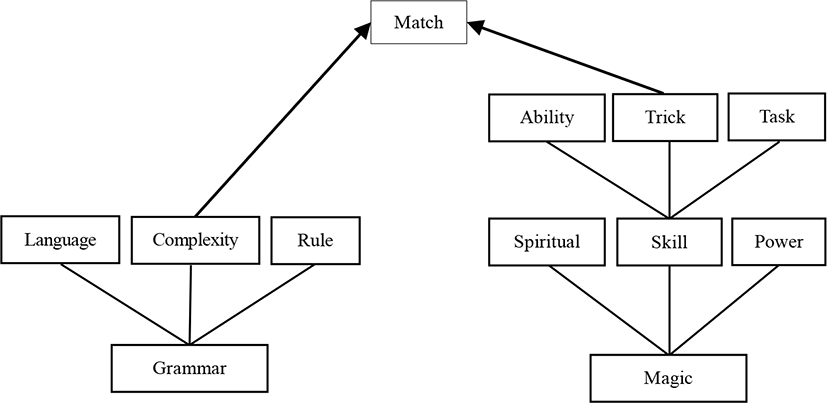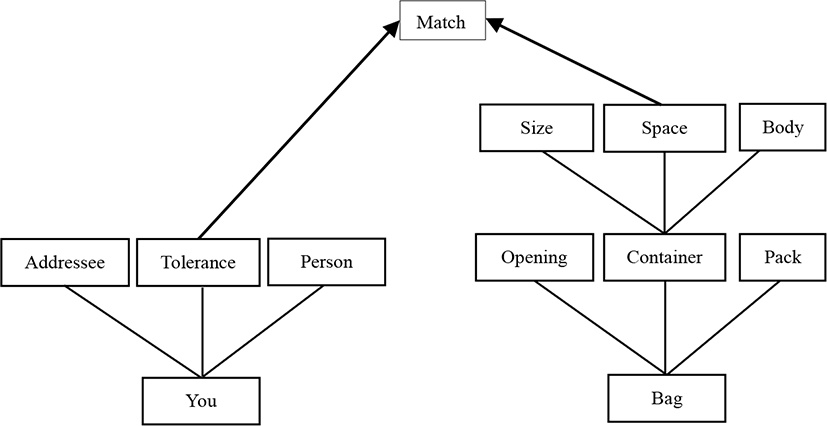1. Introduction
This paper aims at investigating the meaning potential of lexical items used in constructing metaphorical expressions, and the different processes that are required in actualising the intended meaning via electronic media especially Nollywood films. Metaphor in this paper is described as a semantic shift which enables a word to express an idea it does not literally denote. It may be used for conceptualisation of an idea in a new way and to communicate it in a vivid manner (Gibbs 2013). Constructing the idea in a new way implies a shift in meaning because the lexical items used in the reconstruction of the idea may not literally denote what they say. Fromkin et al. (2003) assert that metaphor is an essential part of semantics without which our ability to communicate effectively and efficiently would be hindered. Their assertion emphasises the contribution of metaphor to meaning making process in the use of language. Metaphor is an aspect of cognitive linguistics which studies how meaning is constructed through cognitive models. Metaphor may be seen as an integral part of culture because language and culture are intertwined (Lakoff & Johnson 1980, Lakoff & Kovecses 1987, Quinn 1991, Yuanqiong 2009). Metaphorical linguistic expressions are used to express the cultural values and beliefs of the people of a society (Sobola 2016). Therefore, members of speech communities use metaphors to communicate their worldviews (Lakoff & Johnson 1980, Kovecses 2010). Native speakers of a language use the images available in their culture to construct their metaphors; therefore, different languages and cultures employ diverse images in the construction of their metaphorical expressions (Sobola 2018/2019). These images are part of their cognitive realities through which their cognitive system processes and interprets objects, values and beliefs (Sobola 2018). These cultural objects, values and beliefs expressed through metaphorical expressions are projected through social interactions and communicative channels one of which is electronic media.
2. Data
Film serves as the source of data for this study. Film is a form of entertainment through electronic media. It is called screen discourse (Taylor 2004). It is also known as motion picture and defined as “a series of sequentially ordered photographs or drawings (known as frames) recorded on one or more reels of film and projected at a speed unto a screen by strong, focused light, giving an impression of natural motion” (McArthur et al. 1992). Discourse is language in use (Brown & Yule 1983, Fasold 1990). Film as discourse portrays social relationships among the interlocutors in the film, and between the characters and the audience through multimodal means (Taylor 2004). It has a social context in which language functions. Films are adapted from written text known as a script, and the script may be a literary text of either prose or drama genre (Onyekaba 2014). Monaco (1981) and Chan & Herroro (2010) establish that the link between language and film is communication. Metaphorical expressions are often found as part of language use in films which is a representation of language use in society (Sobola & Agboola 2016). On the basis of this, Whittock (1990: 3) asserts that “commentators regularly identify metaphors when attempting to explicate films. Those metaphors are referred to as cinematic metaphors.” The assertion indicates that the place of metaphor in the interpretation of film is crucial as it contributes towards creativities in the language use in the popular culture. Linguistic creativity, at times, affects the cognitive processes involved in comprehension of a text.
A few scholarly works have been done on the study of metaphor by various linguists. Perrine (1971) classified metaphors into four forms according to their structure. Searle (1979) in relation to other scholars has engaged in a quest for a theory of metaphor that states the principles that relate literal sentence to metaphorical meaning utterance. Opeibi (2009) explored metaphor as a persuasive technique in political discourse. Papagno (2001) studied metaphors and idioms in medical discourse with a focus on the language use of patients with Alzheimer’s disease. Bielena-Grajewska (2009) investigated the language of investment in the banking sector.
Metaphorical expressions are often found as part of language use in films because the use of language in film is quintessential of the use of language in society. On the basis of this, Whittock (1990: 3) asserts that “commentators regularly identify metaphors when attempting to explicate films. Those metaphors are referred to as cinematic metaphors.” Whittock’s argument is that there are metaphors in film which are called cinematic metaphors. Other studies on metaphor and film are done by some scholars in the field of language and film. Comanducci (2010) conducted a study on metaphor and ideology in film which focused on the role of ideology in constructing metaphors found in films. Coegnart & Kravanja (2012) carried out a study which provided a theoretical framework for analysing structural conceptual metaphors and image metaphors in film which focused on how metaphor can be identified. Forceville & Renton (2013) also studied orientational metaphor in film by focusing on the use of conceptual metaphor—good is light and bad is darkness—in three selected films to demonstrate how light and darkness are representatives of good and evil. All these works focused on the role of metaphor in social communication through films.
Nigerian films can be described as a community product through which members can find shared meaning and representation of their daily life and their community’s worldview (Dipio 2008). Nigeria is a nation with linguistic diversity and cultural differences where English functions as an official language and language of unity. Nigerian screenwriters choose language that is suitable for the context of their films. Some of them resolve to use indigenous languages because they believe that English does not have sufficient sociolinguistic facilities to express the thought and cultural realities they intend to portray. Therefore, some Nigerian films are produced in Nigerian indigenous languages and subtitled in English while others are produced in English with cultural elements of Nigerian languages such as metaphors, proverbs and idioms (Achebe 1965).
Nollywood is a name given to Nigerian film industry. The term was first used in the New York Times by Matt Steinglass in 2002 who was in search of a name for the emerging Nigerian video film industry. He used N- to connote Nigeria and called the industry Nollywood after the American Hollywood and the Indian Bollywood (Haynes 2005, Oni 2008). Nollywood started with roving theatre groups known as “Alarinjo” the Yoruba travelling theatre troupes who moved from place to place in villages and cities to stage their plays (Adesanya 1997, Haynes & Okome 1997). Evolution of anindigenous cinema in Nigeria began with their involvement in motion picture production in the mid ’70s (Adesanya 1997). They produced films in their indigenous language to meet their audience demand for home entertainment and also featured on television programmes, soap operas, organised by Nigerian Television Authority (NTA) (Haynes & Okome 1997). The name did not survive without resistance from some stakeholders in the industry, yet it has become the identity of the industry.
3. Theory of Lexical Concept and Cognitive Model
Vyvyan Evans (2006, 2009a, 2009b, 2010, 2013a, 2013b) proposes a theoretical model for analysis of figurative language, especially metaphor and metonymy known as the theory of lexical concept and cognitive model (LCCM). The theory came about with the claim that conceptual metaphor theory (CMT) of Lakoff & Johnson (1980) could not effectively account for linguistic features of figurative language.
The theory accounts for lexical representation and semantic composition in figurative language. It is based on lexical approach to meaning construction. Its intention is to give account of systematic patterns in metaphoric thinking and language from the point of view of process of meaning-construction, semantic change and language users, and at the same time revealing psychological reality in language and meaning.
The theory assumes that meaning should be seen as a process or an act but not as a structure that can be assembled. In addition, it suggests that meaning is derived from how words are used in utterances, that is, how they activate and depict conceptual knowledge; the way the knowledge employed by the speaker to express his communicative intention is composed.
Lexical concept integration identifies semantic potential of lexical concepts subjected to matching and links the particular features of the two lexical concepts that help in realising the linguistic meaning among other linguistic items in a metaphorical expression through the process of matching. There are processes involved in lexical concept integration. A lexical concept expedites access to several cognitive models, which are also linked to other cognitive models. The useful tool in this analysis is the cognitive model profile which a lexical concept expedites access to, which is also known as semantic potential. The cognitive model profile is the extent to which a lexical concept activates to either directly or indirectly (Evans 2013b). The cognitive models to which a lexical concept allows access directly are primary cognitive models while those that are indirectly accessed are secondary cognitive models. The secondary cognitive models are cognitive model profile for one of the primary cognitive models.
For matching to take place, open-class lexical concepts in the lexical conceptual unit activate part(s) of the conceptual content they expedite access to. The part of semantic potential that is activated is constrained by the nature of semantic value, that is, the meaning expected from integration. Integration, which is the opening of linguistic content for activation, is followed by interpretation, which is the activation of conceptual content.
Only the open-class lexical concepts undergo interpretation in a lexical conceptual unit. The outcome of interpretation enables the open-class lexical concepts to achieve semantic interpretation known as informational characterisation. This is as a result of activation of relevant parts of semantic potential which the lexical concepts facilitate access to (Evans 2010).
Each cognitive model from the open-class lexical concepts in the lexical conceptual unit is an interpretation. Matching brings out the interpretation that is produced by linking the appropriate cognitive models from the lexical concepts chosen in the conceptual lexical unit. Once there is a match between one or more cognitive models in the cognitive model profiles associated with relevant lexical concepts, interpretation then takes place.
Matching is constrained by two principles: principle of conceptual coherence and principle of schematic coherence. The principle of conceptual coherence states that matching occurs between one or more cognitive models which belong to different cognitive model profiles. This principle depends on the principle of schematic coherence which states that the conceptual content associated with entities, participants and the relations between them must exhibit coherence in fusion (ibid.). The two principles ensure that matching takes place only when the cognitive models that undergo matching are from distinct cognitive model profiles, and they are accessed by different lexical concepts, and at the same time, it must portray coherence in fusion.
Matching is done by conducting a search in the primary cognitive model profiles of two lexical concepts subjected to matching. If the matching is not successful in the primary domain, a new search domain is established in the secondary cognitive model profile to identify the cognitive models there, out of which a model is matched to the model that attains coherence in another lexical concept subject to matching.
4. Methodology
Data for this study were elicited from electronic media which serves as the source of data. Two Nigerian films were watched on the internet through the YouTube platform and downloaded accordingly. One of them is a Nigerian film in Yoruba subtitled in English, and the other is a Nigerian film in English. Ten metaphorical expressions were extracted from each film. The researcher’s knowledge of Yoruba language and the English subtitling aid translation of metaphors in the Nigerian film in Yoruba. The data are presented and three metaphors from each of the films are analysed. The first, third and fifth metaphors are analysed respectively. Table 1 contains ten metaphors from a Nigerian film in Yoruba subtitled in English while Table 2 contains ten metaphors from a Nigerian film in English.
5. Lexical Presentation of Figurative Language
<Example I>
In my wife and children are my property, the open-class lexical concepts, wife and children and property, are selected for matching in the lexical conceptual unit. Here, ‘wife and children’ function as a compound subject which stands as a lexical concept. The primary cognitive model profiles of the two lexical concepts are searched for identification of the cognitive models in each of the cognitive model profiles. In Figure 1 below, lexical concept, wife and children, affords access to the cognitive models—family, subordinate, dependant. The other lexical concept, property, facilitates access to the cognitive models—object, possession attribute. Schematic coherence could not be achieved for the two lexical concepts at this level so as to create a match. Therefore, secondary cognitive model profile for possession, which is a primary cognitive model for the target lexical concept, property, is established. The cognitive model profile for possession contains the cognitive models—estate, dominion, resources. It is only dominion among the cognitive models in the cognitive model profile for possession that attains schematic coherence to establish a match with one of the cognitive models for the lexical concept, wife and children. The cognitive model, subordinate from the lexical concept, wife and children, has possibility of sharing similar semantic potential with dominion which is a secondary cognitive model for the lexical concept, property.
The match takes place between a primary cognitive model for the lexical concept, wife and children and a secondary cognitive model for the lexical concept, property. The primary cognitive model, subordinate and a secondary cognitive model, dominion for the lexical concepts, wife and children and property respectively, attain schematic coherence which allows matching to take place between the two lexical concepts.
The informational characterisation of the metaphor is that subordinate, which is one of the interpretations of the lexical concept, wife and children, is coherent with dominion which is one of the interpretations in the lexical concept, property. The matching that takes place makes it possible to identify semantic potential of wife and children which is subordinate, which connects the semantic potential of property—dominion. The match explores interpretation of the two interpretations that connect among other interpretations of the two lexical concepts. Wife and children are understood as property as a result of subordinate found in its cognitive model profile. This cognitive process is based on the cultural perspective of the setting of the film, which is a patriarchal society. In the Yoruba socio-cultural setting, a wife is believed to be under absolute authority of her husband and expected to train her children to be submissive to their father, especially if she is traditionally married with the payment of the bride price to the bride’s family.
In you are Nokia, the open-class lexical concepts, you and Nokia, are selected for matching in the lexical conceptual unit. The primary cognitive model profiles of the two lexical concepts are searched for identification of the cognitive models in each of the cognitive model profiles. In Figure 2 below, the lexical concept, you, affords access to the cognitive models—person, strong, addressee. The other lexical concept, Nokia, facilitates access to the cognitive models—phone, durability, brand. Schematic coherence could not be achieved for the two lexical concepts at this level so as to create a match. Therefore, secondary cognitive model profile for durability, which is a primary cognitive model for the target lexical concept Nokia, is established. The cognitive model profile for durability contains the cognitive models—lasting, rugged, indestructible. It is only rugged among the cognitive models in the cognitive model profile for durability that attains schematic coherence to establish a match with one of the cognitive models for the lexical concept, you. The cognitive model—strong from the lexical concept, you, has possibility of sharing similar semantic potential with rugged which is a secondary cognitive model for the lexical concept Nokia.
The match takes place between a primary cognitive model for the lexical concept, you and a secondary cognitive model for the lexical concept, Nokia. The primary cognitive model, strong and a secondary cognitive model, rugged for the lexical concepts, you and Nokia respectively, attain schematic coherence which allows matching to take place between the two lexical concepts.
The informational characterisation of the metaphor is that strong, which is one of the interpretations of the lexical concept, you, is coherent with rugged, which is one of the interpretations in the lexical concept Nokia. The matching that takes place makes it possible to identify semantic potential of you which is strong, which connects the semantic potential of Nokia—rugged. The match explores interpretation of the two interpretations that connect among other interpretations of the two lexical concepts. The pronoun, you, is understood as Nokia as a result of strong found in its cognitive model profile.
The culture of associating a person with animate and inanimate objects as a result of their attributes thrives in Nigeria, and it has generated social metaphors that contribute to the linguistic peculiarity of the country.
In my child is my mirror, the open-class lexical concepts, child and mirror, are selected for matching in the lexical conceptual unit. The primary cognitive model profiles of the two lexical concepts are searched for identification of the cognitive models in each of the cognitive model profiles. Figure 3 below shows that the lexical concept, child, affords access to the cognitive models—parents, resemblance, infant. The other lexical concept, mirror, facilitates access to the cognitive models—glass, reflection, metal. Schematic coherence could not be achieved for the two lexical concepts at this level so as to create a match. Therefore, secondary cognitive model profile for reflection, which is a primary cognitive model for the target lexical concept, mirror, is established. The cognitive model profile for reflection contains the cognitive models—image, picture, shadow. It is only picture among the cognitive models in the cognitive model profile for reflection that attains schematic coherence to establish a match with one of the cognitive models for the lexical concept, child. The cognitive model, resemblance from the lexical concept, child, has possibility of sharing similar semantic potential with picture which is a secondary cognitive model for the lexical concept, mirror.
The match takes place between a primary cognitive model for the lexical concept, child and a secondary cognitive model for the lexical concept, mirror. The primary cognitive model, resemblance and a secondary cognitive model, picture for the lexical concepts, child and mirror respectively, attain schematic coherence which allows matching to take place between the two lexical concepts.
The informational characterisation of the metaphor is that resemblance, which is one of the interpretations of the lexical concept, child, is coherent with picture which is one of the interpretations in the lexical concept, mirror. The matching that takes place makes it possible to identify semantic potential of child which is resemblance, which connects the semantic potential of mirror—picture. The match explores interpretation of the two interpretations that connect among other interpretations of the two lexical concepts. Child is understood as a mirror as a result of resemblance found in its cognitive model profile. This metaphor found its root in the Yoruba socio-cultural setting, where the issue of child-bearing in marriage is very serious. This issue also exists in different societies of the world.
<Example II>
In your shoe is a storey building, the open-class lexical concepts, shoe and building, are selected for matching in the lexical conceptual unit. The primary cognitive model profiles of the two lexical concepts are searched for identification of the cognitive models in each of the cognitive model profiles. Figure 4 below depicts that the lexical concept, shoe, affords access to the cognitive models—sole, heel, leather. The other lexical concept, building, facilitates access to the cognitive models—concrete, storey, house. Schematic coherence could not be achieved for the two lexical concepts at this level so as to create a match. Therefore, secondary cognitive model profile for storey, which is a primary cognitive model for the target lexical concept building, is established. The cognitive model profile for storey contains the cognitive models—high, level. It is only high among the cognitive models in the cognitive model profile for storey that attains schematic coherence to establish a match with one of the cognitive models for the lexical concept, shoe. The cognitive model—heel from the lexical concept, shoe, has possibility of sharing similar semantic potential with high which is a secondary cognitive model for the lexical concept building.
The match takes place between a primary cognitive model for the lexical concept, shoe and a secondary cognitive model for the lexical concept, building. The primary cognitive model, heel and a secondary cognitive model, high for the lexical concepts, shoe and building respectively, attain schematic coherence which allows matching to take place between the two lexical concepts.
The informational characterisation of the metaphor is that heel, which is one of the interpretations of the lexical concept, shoe, is coherent with high, which is one of the interpretations in the lexical concept building. The matching that takes place makes it possible to identify semantic potential of shoe which is heel, which connects the semantic potential of building—high. The match explores interpretation of the two interpretations that connect among other interpretations of the two lexical concepts. The noun, shoe, is understood as a building as a result of heel found in its cognitive model profile.
In big grammar is the magic, the open-class lexical concepts, grammar and magic, are selected for matching in the lexical conceptual unit. The primary cognitive model profiles of the two lexical concepts are searched for identification of the cognitive models in each of the cognitive model profiles. As illustrated in Figure 5 below, the lexical concept, grammar, affords access to the cognitive models—language, complexity, rule. The other lexical concept, magic, facilitates access to the cognitive models—spiritual, skill, power. Schematic coherence could not be achieved for the two lexical concepts at this level so as to create a match. Therefore, secondary cognitive model profile for skill, which is a primary cognitive model for the target lexical concept, magic, is established. The cognitive model profile for skill contains the cognitive models—ability, trick, task. It is only trick among the cognitive models in the cognitive model profile for skill that attains schematic coherence to establish a match with one of the cognitive models for the lexical concept, grammar. The cognitive model, complexity from the lexical concept, grammar, has possibility of sharing similar semantic potential with trick which is a secondary cognitive model for the lexical concept, magic.
The match takes place between a primary cognitive model for the lexical concept, grammar and a secondary cognitive model for the lexical concept, magic The primary cognitive model, complexity and a secondary cognitive model, trick for the lexical concepts, grammar and magic respectively, attain schematic coherence which allows matching to take place between the two lexical concepts.
The informational characterisation of the metaphor is that complexity, which is one of the interpretations of the lexical concept, grammar, is coherent with trick which is one of the interpretations in the lexical concept, magic. The matching that takes place makes it possible to identify semantic potential of grammar which is complexity, which connects the semantic potential of magic—skill. The match explores interpretation of the two interpretations that connect among other interpretations of the two lexical concepts. Grammar is understood as a magic as a result of complexity found in its cognitive model profile.
In you are a bag of trouble, the open-class lexical concepts, you and bag, are selected for matching in the lexical conceptual unit. The primary cognitive model profiles of the two lexical concepts are searched for identification of the cognitive models in each of the cognitive model profiles. The lexical concept, you, affords access to the cognitive models—addressee, tolerance, person. The other lexical concept, bag, facilitates access to the cognitive models—opening, container, pack. Schematic coherence could not be achieved for the two lexical concepts at this level so as to create a match. Therefore, secondary cognitive model profile for container, which is a primary cognitive model for the target lexical concept bag, is established. The cognitive model profile for container contains the cognitive models—size, space, body. It is only space among the cognitive models in the cognitive model profile for container that attains schematic coherence to establish a match with one of the cognitive models for the lexical concept, you. The cognitive model—tolerance from the lexical concept, you, has possibility of sharing similar semantic potential with space which is a secondary cognitive model for the lexical concept bag.
The match takes place between a primary cognitive model for the lexical concept, you and a secondary cognitive model for the lexical concept, bag as demonstrated in Figure 6 below. The primary cognitive model, tolerance and a secondary cognitive model, space for the lexical concepts, you and bag respectively, attain schematic coherence which allows matching to take place between the two lexical concepts.
The informational characterisation of the metaphor is that tolerance, which is one of the interpretations of the lexical concept, you, is coherent with space, which is one of the interpretations in the lexical concept bag. The matching that takes place makes it possible to identify semantic potential of you which is tolerance, which connects the semantic potential of bag—space. The match explores interpretation of the two interpretations that connect among other interpretations of the two lexical concepts. The pronoun, you, is understood as a bag as a result of tolerance found in its cognitive model profile.
6. Discussion
The lexical concept integration in LCCM theory has been applied to some metaphors used in Nollywood movies to examine features of their lexical items and their semantic potential. Having observed the processes involved in the lexical concept integration, the following findings were made:
Only the open-class lexical concepts in the metaphors used in the Nollywood movies are endowed with semantic potential to undergo interpretation in a lexical conceptual unit, which is a metaphorical expression. For example, in My child is my mirror, child and mirror, which are open-class lexical concepts, are selected for matching which helps to achieve semantic interpretation.
Each open-class lexical concept has cognitive model profile which contains cognitive models—layers of meaning—to which it facilitates access. Each cognitive model is an interpretation with both socio-cultural and linguistic imports. Many cognitive models are found in each cognitive model profile; only a few are chosen when matching is to be done, out of which one will help to achieve the desired meaning. For example, the lexical concept mirror has cognitive model profile—glass, reflection and metal.
Matching brings out the interpretation that is produced by linking the appropriate cognitive models from the cognitive model profiles of the open-class lexical concepts chosen for integration. If matching could not be achieved at this primary level, a secondary cognitive model profile is established in one of the cognitive models in the source concept to identify cognitive models out of which a model is matched to a model that attains coherence in another lexical concept subject to matching. It has been illustrated in the analysis. The interpretations derived from matching the models are socio-cultural based because the models are cultural models.
In the analysis of my wife and children are my property, the interpretation of wife and children as property is culture based. The models in the cognitive model profile for the lexical concept ‘wife and children’ are cultural models because the metaphor is a culture based metaphor, and its interpretation is constrained by cultural norms. The meaning derived from matching the models reflects that the metaphor is domiciled in a society where patriarchy is prevalent. Wife and children are interpreted as the possession of the husband because they are dependent on him as subordinates while he exercises dominion over them as their owner. This cultural meaning is prevalent in the Yoruba cultural society which the film depicts.
In you are Nokia, taxonomic relationship that aids understanding of a person as a brand of mobile phone is based on technological influence. The models in the cognitive model profile for Nokia are both technologically and social based, which portrayed the nature of technology in society. The metaphor is novel and can be classified as a technological or new media metaphor. The durability model in the profile of the phone creates a platform for interpreting a person as a brand of a mobile phone. The meaning shared is synonymous to strength and ability to withstand pressure because the first brand of Nokia phone that was imported into Nigeria was notorious for being rugged. Due to harsh economic situation in Nigeria, the Nigerians believe that they are strong enough to withstand the economic difficulties as the Nokia phone is not easily damaged by rough handling.
Interpretation of child as mirror is culture based, but this culture is shared by many societies that believe in hereditary transfer of genes. Resemblance is the model in the cognitive model profile for child that makes its interpretation as mirror possible. As mirror reflects the image of the beholder, children are expected to resemble their parents physiologically, mentally and socially. This metaphor has been used to proffer solutions to some controversial pregnancies where there exists confusion over the paternity of the child. Once the controversial child has a total resemblance of the doubting father at birth, the issue is resolved.
The metaphor, your shoe is a storey building, is novel and depicts linguistic creativity of the speaker that makes him to conceptualise a shoe as a storey building. Taxonomic relationship of the two concepts is based on one of the models in the cognitive model profile for shoe, ‘heel’, and the model ‘high’ in the secondary cognitive model profile for building. Matching of the two models serves as a platform on which interpretation of a shoe as a storey building is made possible.
Big grammar is the magic is a new metaphor that can be categorised as a metaphor of education. This metaphor is often used in a context where educated people used the knowledge of their study to confuse others. Complexity is the model in the cognitive model profile for grammar enables interpretation of grammar as magic. In most developing countries where English is used as the second language, English grammar constitutes the major problem to the learners of English because of its complexity. Inability of some teachers of to simplify the subject makes it appear like magic to the learners. Therefore, some students from illiterate homes use their knowledge of English grammar to exploit their parents and their neighbours. Complexity in grammar is equated to trick in magic, which makes the interpretation possible.
You are a bag of trouble is a metaphor of container based on the storage capacity of the figurative word in the metaphor. The attribute of tolerance in humans which serves as a model in the cognitive model profile for you has made the interpretation of a human being as a bag possible. Tolerance, which is the ability to accommodate people including those who hurt someone, is described as a space in a bag, The space enables a bag to accommodate loads kept inside it. The model of tolerance and space in the primary cognitive model profile for you and the secondary cognitive model profile for bag respectively makes it possible for the interpretation of a person as a bag which may contain trouble.
7. Conclusion
This paper has investigated the semantic potential of lexical items in the metaphorical expressions in Nollywood films, and how their intended meaning is realised. The study has shown that socio-cultural and linguistic context of language use determines the realisation of intended meaning. As metaphors are constructed with images available in the culture where the metaphors emanate from, metaphors are best interpreted in relation to socio-cultural base of their source. The cognitive models that aid interpretation of the metaphors are socio-cultural images grounded in the linguistic situation of the society. If selection of the models is not properly done, a different layer of meaning might be produced from the metaphor.







